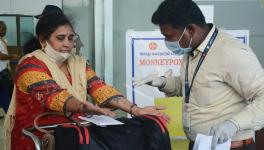New ‘COVID Tongue’ Symptom Identified, Claims Expert

Apart from the common symptoms like fever, fatigue, and sore throat that can be seen everywhere, new and unusual symptoms have also emerged during the pandemic. Now, a leading epidemiologist from King’s College, London, has claimed that there is an increase in cases where COVID-19 patients suffer from an unusual symptom of oral ulcer. However, this has not been listed by the WHO (World Health Organization) as one of the COVID-19 symptoms.
Professor Tim Spector of King’s College claimed in his tweet that such cases of oral ulcer are increasing in the country. He wrote, “One in five people with Covid still present with less common symptoms that don't get on the official PHE (Public Health England) list - such as skin rashes.”
He further added, “Seeing increasing numbers of Covid tongues and strange mouth ulcers. If you have a strange symptom or even just headache and fatigue stay at home!”
However, neither WHO nor the CDC (Centre for Disease Control and Prevention) in the Unites States has made any mention of oral symptoms.
Professor Tim Spector is not the first one to report COVID-19 symptoms that are related to oral ulceration or infection in the mouth. Last year in June a team from UK also published a report about oral ulceration and blistering in COVID-19 patients. It was published in Nature.
Likewise, another group of researchers from Spain reported about oral rashes in COVID-19 patients that also had skin rashes. This was published in JAMA dermatology in July last year. Both these reports, however, had a small dataset. Again, a New York Times article recently said that there can be oral complications in people who suffered from COVID-19, such as teeth falling out, developing sensitivity in gums, cracking of teeth and even teeth turning grey.
The latest, as claimed by prof. Tim Spector to have observed in COVID-19 patients, are symptoms like developing thick patches all over the tongue. The coated or patched tongue, as termed by prof. Spector, is called ‘COVID tongue’. However, scary this might sound, the condition has not been linked to be anything dangerous clinically and the patient could recover well within a week or so.
The cautionary message it conveys is that even oral problems should not be reluctantly taken and it’s better to visit a doctor for a proper diagnosis for checking up whether a viral contraction has taken place or not.
In earlier instances, COVID-19 did puzzle experts and scientists regarding symptoms. As early as May last year during the pandemic, skin rashes including COVID Toes had raised alarms. The WHO also included “different types of skin rashes” as a symptom of the disease that is less common.
The list of symptoms that WHO publishes has two categories—the common symptoms and the not-so-common symptoms. The common symptoms enlisted are fever, dry cough and fatigue.
Other symptoms that are not very common, according to WHO categorization, are—loss of taste or smell, nasal congestion, conjunctivitis, sore throat, joint pain or muscle pain, skin rashes, nausea, diarrhea and dizziness or chills.
The WHO symptom list also has symptoms for severe COVID-19 disease and these include shortness of breath, loss of appetite, confusion, chest pain along with high temperature above 100 degree Fahrenheit.
Symptoms that can be even severe and are related to cognitive abilities, according to WHO, are rare neurological complications like stroke, delirium, nerve damage etc. Apart from these, irritability, confusion, depression, anxiety, sleep disorders, reduced consciousness are also COVID-19 related symptoms in severe cases.
Get the latest reports & analysis with people's perspective on Protests, movements & deep analytical videos, discussions of the current affairs in your Telegram app. Subscribe to NewsClick's Telegram channel & get Real-Time updates on stories, as they get published on our website.






















